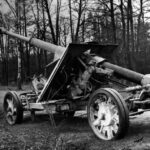U.S. Troops Fire Captured Pak 43
Soviet 8,8 cm Pak 43-41
Pak 43-41 Wien 1945
Pak 43-41
PaK 43 SWS
Pak 43 Normandy
Panzerabwehrkanone 43-41
Pak 43-41 Caen 8 August 1944
Pak 43-41
Pak 43-41
PaK 43
Panzerjägerkanone 43
Pak 43
Pak 43
Pak 43 L/71
Anti-tank gun Pak 43-41
German Pak 43 Normandy
Captured German Pak 43 Guns in Rheims
8,8 cm Pak 43-41
8,8 cm PaK 43/3 mit Behelfslafette
8,8 cm PaK 43/3 mit Behelfslafette
8,8 cm PaK 43/3 mit Behelfslafette
8,8 cm PaK 43/3 mit Behelfslafette
8,8 cm PaK 43/3 mit Behelfslafette
8,8 cm PaK 43/3 mit Behelfslafette
The 8.8 cm Panzerabwehrkanone 43 was an innovation by Krupp, evolving from the planned 8.8 cm Pak 42. It was introduced into active service in the latter part of 1943. The Pak 43, a semi-automatic gun, employed electrical ignition and was affixed to a cruciform platform known as the Krenzlafette. This platform was transported using two single axle limbers (Sd. Ah. 204), similar to those utilized for the 8.8cm Flak 18. This artillery piece presented an impressively low profile while on wheels, measuring 1.6 meters to the crest of the shield and 1.21 meters to the trunnions. Once positioned, it sat 304 mm lower. Firing could be executed while still on its wheels without the need to extend the side legs, as long as the firing direction stayed within a 30° arc on either side of the longitudinal beams. Beyond this range, when firing required an angle greater than 30°, the side legs would be extended and the pads firmly grounded. An automatic electric cutoff mechanism was integrated into the firing mechanism. This feature limited the elevation to 12° on earlier iterations and 16° on subsequent versions when firing over the mounting legs. The gun excelled in penetration capabilities and was widely regarded as the most exceptional anti-tank artillery of the conflict. When incorporated into divisional artillery regiments as field artillery, it adopted the designation 8.8cm K.43. Certain adaptations of this gun were affixed to self-propelled carriages.
The 43/41 variation emerged in 1943 as a response to the challenge of producing enough cruciform carriages to accommodate the mounting of Pak 43 gun barrels, which were in high demand. This particular version involved the installation of the gun, complete with a muzzle brake, on a two-wheeled carriage. The carriage featured large rubber-tired metal wheels similar to those on the 15cm schwere Feldhaubitze. These wheels were independently sprung on their stub axles. The carriage was equipped with a slanting double shield measuring 1.90 meters in height. Positioned on the left side were two telescopic mounts, one employing a rocking bar mechanism for anti-tank use, while the other facilitated indirect laying. The split trail legs, spanning a length of 3.65 meters, were hinged to a base that also accommodated the upper carriage. These trails, akin to those of the 10.5cm Feldhaubitze, were designed for enhanced stability. The semi-automatic breech mechanism, characterized by its horizontal sliding block design, was operated by a compact auxiliary cylinder located on the left side of the breechblock. A single cylinder held both the buffer and recuperator, positioned above the barrel, with the balancing cylinders mounted vertically on each side of the carriage. Firing was supported by a four-point stance. Due to its considerable size and weight, this weapon earned the moniker “Barndoor”.
























